Unsaturated Response of Clayey Soils Stabilised with Alkaline Cements
Abstract
1. Introduction
2. Results
2.1. Soil Water Retention Curves (SWRC)
2.2. Triaxial Tests
3. Materials and methods
3.1. Materials
3.2. Methods
4. Discussion
5. Conclusions
Author Contributions
Funding
Conflicts of Interest
References
- Cristelo, N.; Glendinning, S.; Fernandes, L.; Pinto, A.T. Effects of alkaline-activated fly ash and Portland cement on soft soil stabilisation. Acta Geotech. 2013, 8, 395–405. [Google Scholar] [CrossRef]
- Corrêa-Silva, M.; Araújo, N.; Cristelo, N.; Miranda, T.; Gomes, A.T.; Coelho, J. Improvement of a clayey soil with alkali activated low-calcium fly ash for transport infrastructures applications. Road Mater. Pavement Des. 2019, 20, 1912–1926. [Google Scholar] [CrossRef]
- Rios, S.; Cristelo, N.; da Fonseca, A.V.; Ferreira, C. Structural performance of alkali-activated soil ash versus soil cement. J. Mater. Civ. Eng. 2016, 28. [Google Scholar] [CrossRef]
- Rios, S.; Cristelo, N.; Miranda, T.; Araújo, N.; Oliveira, J.; Lucas, E. Increasing the reaction kinetics of alkali-activated fly ash binders for stabilisation of a silty sand pavement sub-base. Road Mater. Pavement Des. 2018, 19, 201–222. [Google Scholar] [CrossRef]
- Silva, R.A.; Oliveira, D.V.; Miranda, T.; Cristelo, N.; Escobar, M.C.; Soares, E. Rammed earth construction with granitic residual soils: The case study of northern Portugal. Constr. Build. Mater. 2013, 47, 181–191. [Google Scholar] [CrossRef]
- Rios, S.; Viana da Fonseca, A.; Baudet, B.A. On the shearing behaviour of an artificially cemented soil. Acta Geotech. 2013, 9, 215–226. [Google Scholar] [CrossRef]
- Rodrigues, C.; Rodrigues, P.; Cruz, N.; Rios, S.; Viana da Fonseca, A. Estabilização de solos com geopolímeros para camadas de leito de estradas. In Proceedings of the 15° Congresso Nacional de Geotecnia e 8° Congresso Luso-Brasileiro de Geotecnia, Porto, Portuga, 19–23 June 2016. [Google Scholar]
- Capasso, I.; Lirer, S.; Flora, A.; Ferone, C.; Cioffi, R.; Caputo, D.; Liguori, B. Reuse of mining waste as aggregates in fly ash-based geopolymers. J. Clean. Prod. 2019, 220, 65–73. [Google Scholar] [CrossRef]
- Ferone, C.; Capasso, I.; Bonati, A.; Roviello, G.; Montagnaro, F.; Santoro, L.; Turco, R.; Cioffi, R. Sustainable management of water potabilization sludge by means of geopolymers production. J. Clean. Prod. 2019, 229, 1–9. [Google Scholar] [CrossRef]
- Fernández-Jiménez, A.; de la Torre, A.G.; Palomo, A.; López-Olmo, G.; Alonso, M.M.; Aranda, M.A.G. Quantitative determination of phases in the alkali activation of fly ash. Part I. Potential ash reactivity. Fuel 2006, 85, 625–634. [Google Scholar] [CrossRef]
- Cristelo, N.; Coelho, J.; Miranda, T.; Palomo, Á.; Fernández-Jiménez, A. Alkali activated composites—An innovative concept using iron and steel slag as both precursor and aggregate. Cem. Concr. Compos. 2019, 103, 11–21. [Google Scholar] [CrossRef]
- Zheng, L.; Wang, W.; Shi, Y. The effects of alkaline dosage and Si/Al ratio on the immobilization of heavy metals in municipal solid waste incineration fly ash-based geopolymer. Chemosphere 2010, 79, 665–671. [Google Scholar] [CrossRef] [PubMed]
- Bernal, S.A.; Provis, J.L. Durability of alkali-activated materials: Progress and perspectives. J. Am. Ceram. Soc. 2014, 97, 997–1008. [Google Scholar] [CrossRef]
- Cristelo, N.; Glendinning, S.; Pinto, A.T. Deep soft soil improvement by alkaline activation. Proc. Inst. Civ. Eng. Gr. Improv. 2011, 164, 73–82. [Google Scholar] [CrossRef]
- Pourakbar, S.; Asadi, A.; Huat, B.B.K.; Cristelo, N.; Fasihnikoutalab, M.H. Application of Alkali-Activated Agro-Waste Reinforced with Wollastonite Fibers in Soil Stabilization. J. Mater. Civ. Eng. 2017, 29, 04016206. [Google Scholar] [CrossRef]
- Silva, M.C.A.d. Melhoramento de um Solo Argiloso Com Recurso à Ativação Alcalina de Resíduos Para Aplicação em Infraestruturas de Transporte. Masters’ Thesis, University of Minho, Braga, Portugal, 2016. [Google Scholar]
- Manuel, E. Melhoria do solo residual granítico com recurso à activação alcalina de cinzas volantes, Universidade de Trás-os-Montes e Alto Douro Escola de Ciências e Tecnologia. Available online: https://pdfs.semanticscholar.org/d4db/4fd272ef960f0a4ce08a0a752af62c75f59d.pdf (accessed on 25 May 2013).
- Cristelo, N.; Glendinning, S.; Miranda, T.; Oliveira, D.; Silva, R. Soil stabilisation using alkaline activation of fly ash for self compacting rammed earth construction. Constr. Build. Mater. 2012, 36, 727–735. [Google Scholar] [CrossRef]
- Fredlund, D.G.; Rahardjo, H. Soil Mechanics for Unsaturated Soils; John Wiley & Sons, Inc.: Hoboken, NJ, USA, 1993; ISBN 9780470172759. [Google Scholar]
- Lu, N.; Likos, W.J. Unsaturated Soil Mechanics; John Wiley & Sons, Inc.: River Street, Hoboken, NJ, USA, 2004. [Google Scholar]
- Han, Z.; Vanapalli, S.K. Stiffness and shear strength of unsaturated soils in relation to soil-water characteristic curve. Géotechnique 2016, 66, 627–647. [Google Scholar] [CrossRef]
- Gens, A. Soil–environment interactions in geotechnical engineering. Géotechnique 2010, 60, 3–74. [Google Scholar] [CrossRef]
- ASTM D5298 Standard Test Method for Measurement of Soil Potential (Suction) Using Filter Paper. ASTM Int. 2016, 11, 1–6.
- Ridley, A.M.; Burland, J.B. A new instrument for the measurement of soil moisture suction. Géotechnique 1993, 43, 321–324. [Google Scholar] [CrossRef]
- Fredlund, D.G.; Gitirana, G., Jr. Unsaturated Soil Mechanics as a Series of Partial Differential Equations. In Proceedings of the Proceedings of International Conference on Problematic Soils, Nottingham, UK, 29–30 July 2003; Eastern Mediterranean University: Famagusta, N. Cyprus, 2005; pp. 25–27. [Google Scholar]
- Vahedifard, F.; Cao, T.D.; Thota, S.K.; Ghazanfari, E. Nonisothermal models for soil-water retention curve. J. Geotech. Geoenviron. Eng. 2018, 144. [Google Scholar] [CrossRef]
- Koliji, A.; Laloui, L.; Cusinier, O.; Vulliet, L. Suction induced effects on the fabric of a structured soil. Transp. Porous Media 2006, 64, 261–278. [Google Scholar] [CrossRef]
- Fernández-Jiménez, A.; Palomo, A.; Criado, M. Microstructure development of alkali-activated fly ash cement: A descriptive model. Cem. Concr. Res. 2005, 35, 1204–1209. [Google Scholar] [CrossRef]
- Elliott, G.M.; Brown, E.T. Yield of a soft, high porosity rock. Géotechnique 1985, 35, 413–423. [Google Scholar] [CrossRef]
- Cristelo, N.; Miranda, T.; Oliveira, D.V.; Rosa, I.; Soares, E.; Coelho, P.; Fernandes, L. Assessing the production of jet mix columns using alkali activated waste based on mechanical and financial performance and CO2 (eq) emissions. J. Clean. Prod. 2015, 102, 447–460. [Google Scholar] [CrossRef]
- Rodríguez, E.D.; Bernal, S.A.; Provis, J.L.; Paya, J.; Monzo, J.M.; Borrachero, M.V. Effect of nanosilica-based activators on the performance of an alkali-activated fly ash binder. Cem. Concr. Compos. 2013, 35, 1–11. [Google Scholar] [CrossRef]
- ASTM D2487 Standard Practice for Classification of Soils for Engineering Purposes (Unified Soil Classification System). ASTM Int. Annu. B. Stand. 2000, 1–12.
- AASHTO M 145-91 Standard Specification for Classification of Soils and Soil-Aggregate Mixtures for Highway Construction Purposes. Am. Assoc. State Highw. Transp. Off. 2008.
- ASTM C618 Standard specification for coal fly ash and raw or calcined natural pozzolan for use in concrete. ASTM Int. Annu. B. Stand. 2012, 1–5.
- BSi 1377-4 BS 1377-4: 1990 - Methods of test for soils for civil engineering purposes, Part 4: Compaction-Related Tests. Br. Stand. Inst. Lond. 1990, 4.
- Van Genuchten, M.T. A Closed-form Equation for Predicting the Hydraulic Conductivity of Unsaturated Soils1. Soil Sci. Soc. Am. J. 1980, 44, 892. [Google Scholar] [CrossRef]
- Topa Gomes, A.; Viana Da Fonseca, A.; Silva Cardoso, A. Soil water characteristic curve for a granite residual soil: Experimental and numerical results. Defect Diffus. Forum 2011, 312–315, 1172–1177. [Google Scholar]
- Fredlund, D.G.; Xing, A. Equations for the soil-water characteristic curve. Can. Geotech. J. 1994, 31, 521–532. [Google Scholar] [CrossRef]
- BSi 1377-8 BS 1377-8: 1990 - Methods of test for soils for civil engineering purposes, Part 8: Shear strength tests (effective stress). Br. Stand. Inst. Lond. 1990, 8.
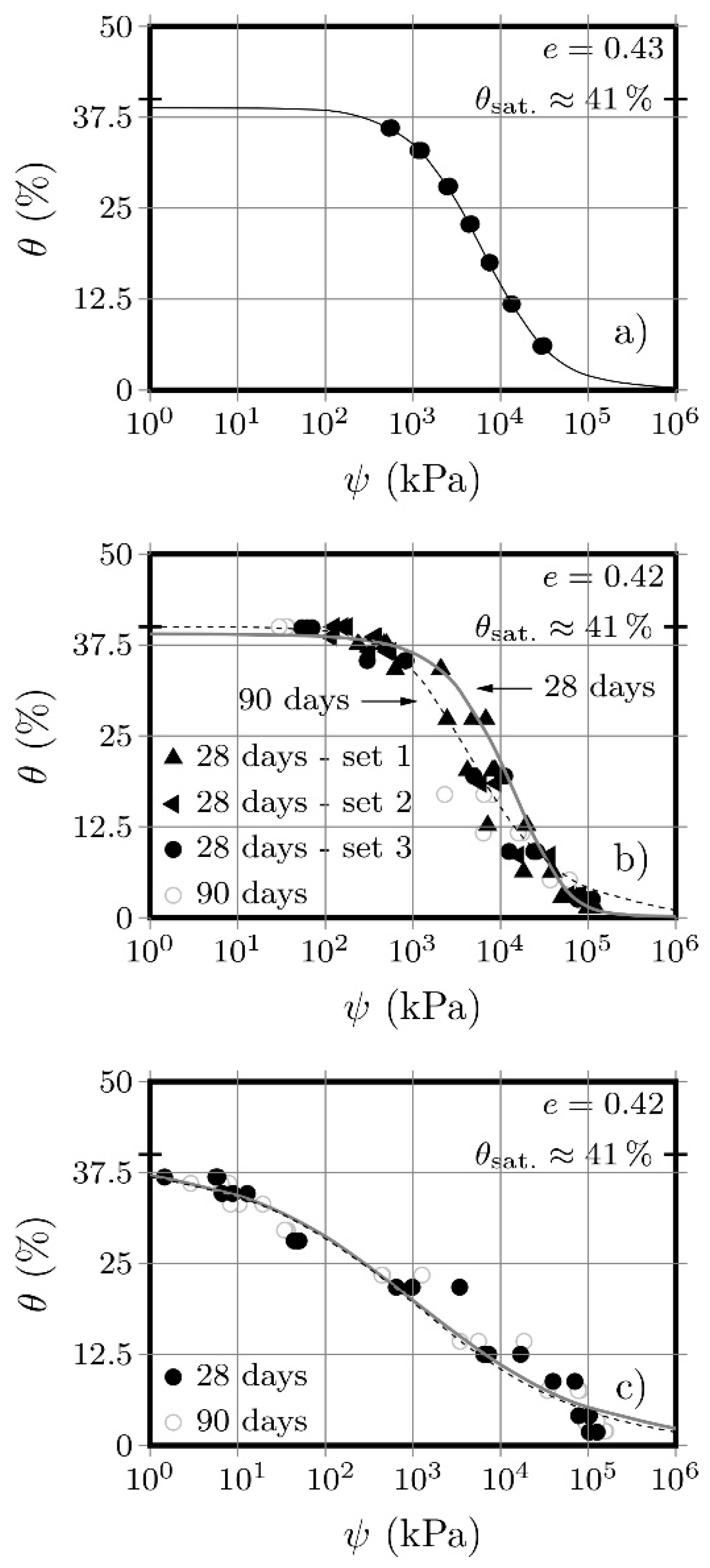
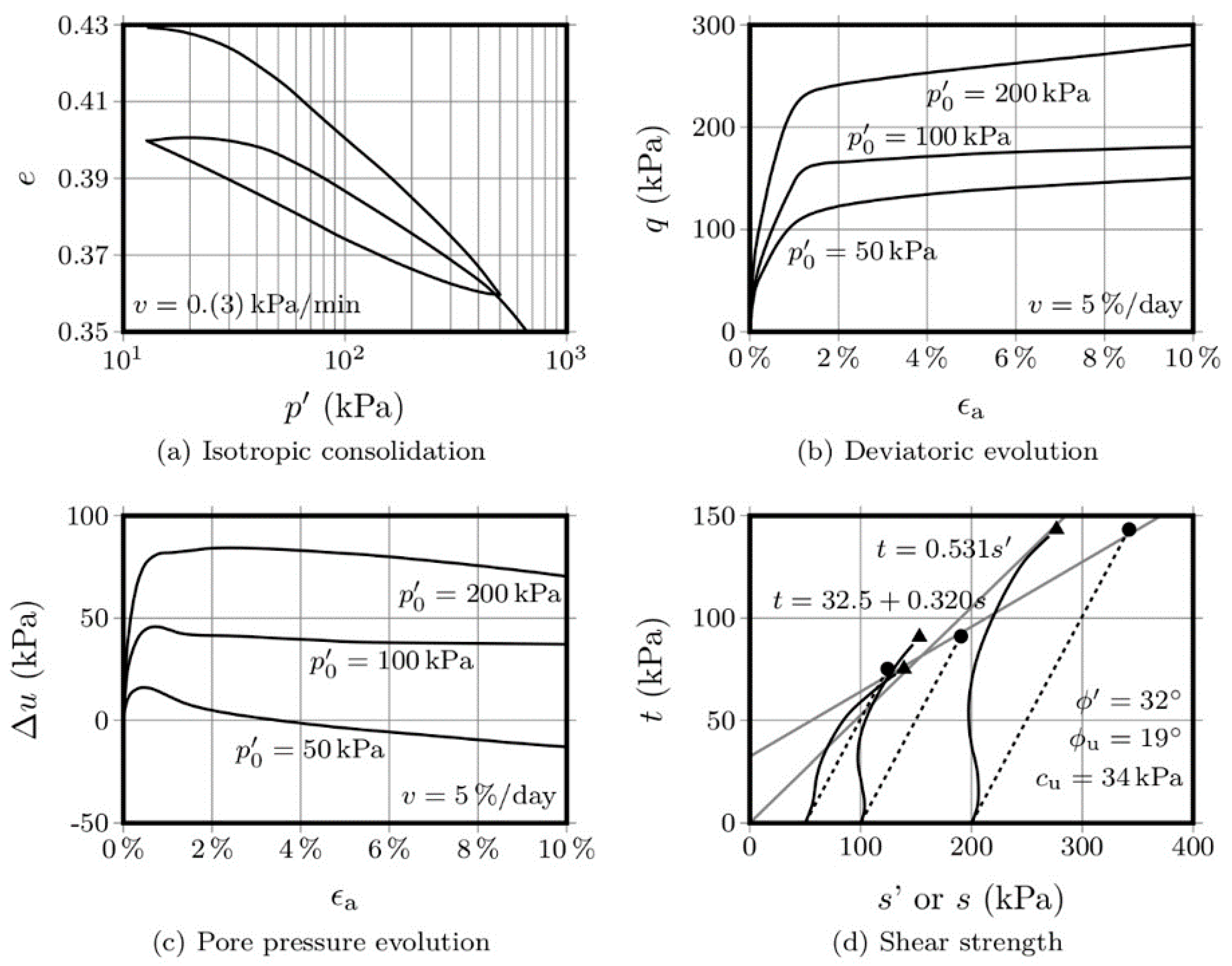
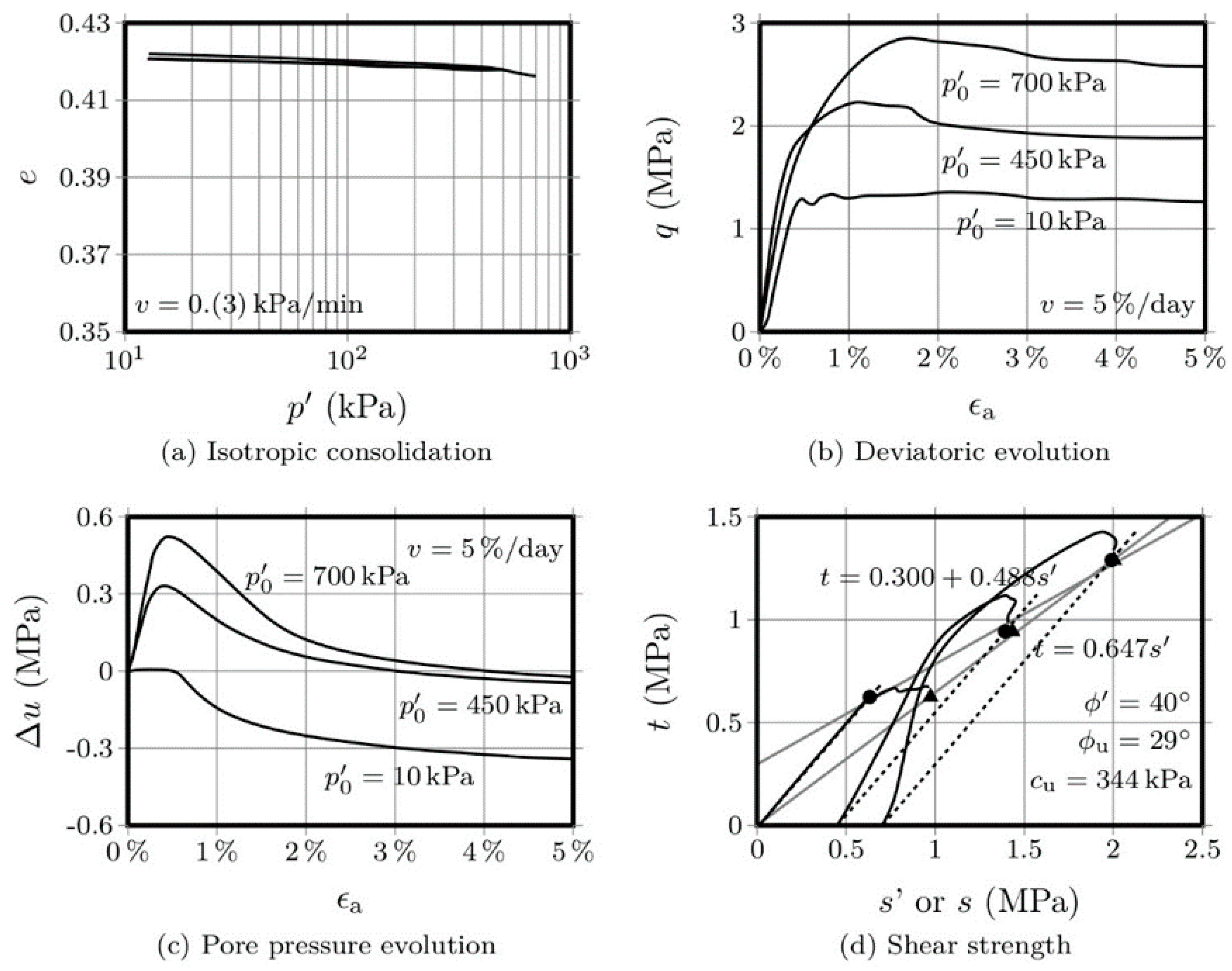
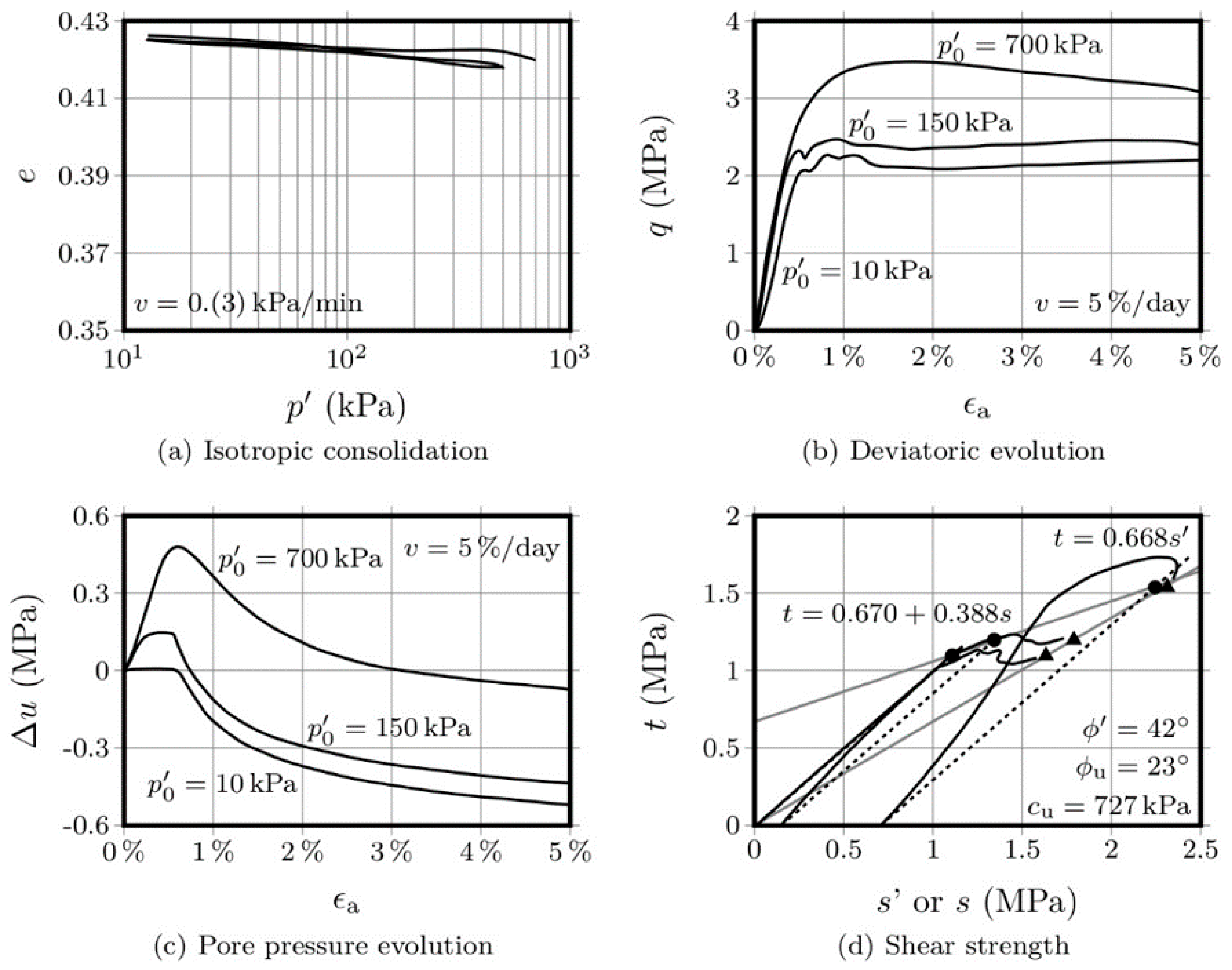
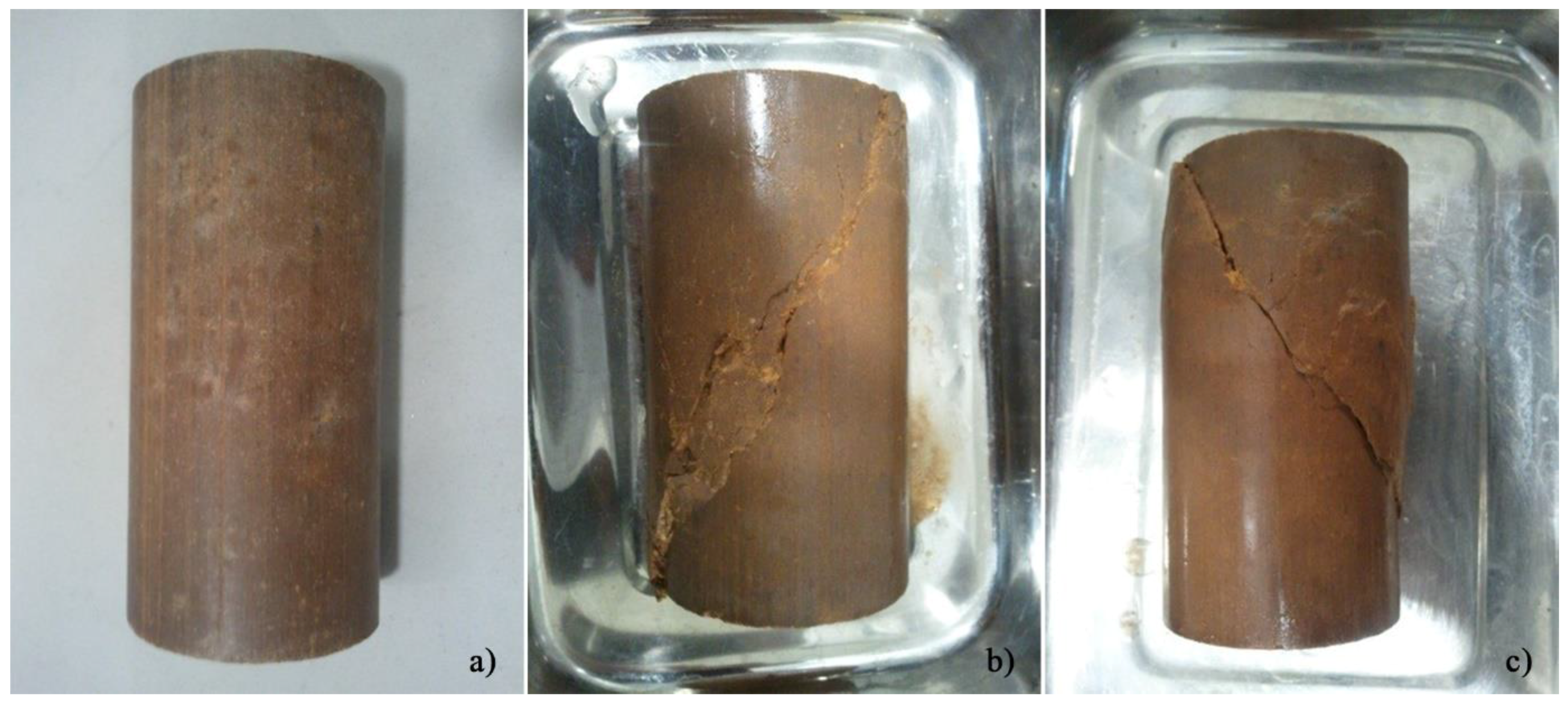

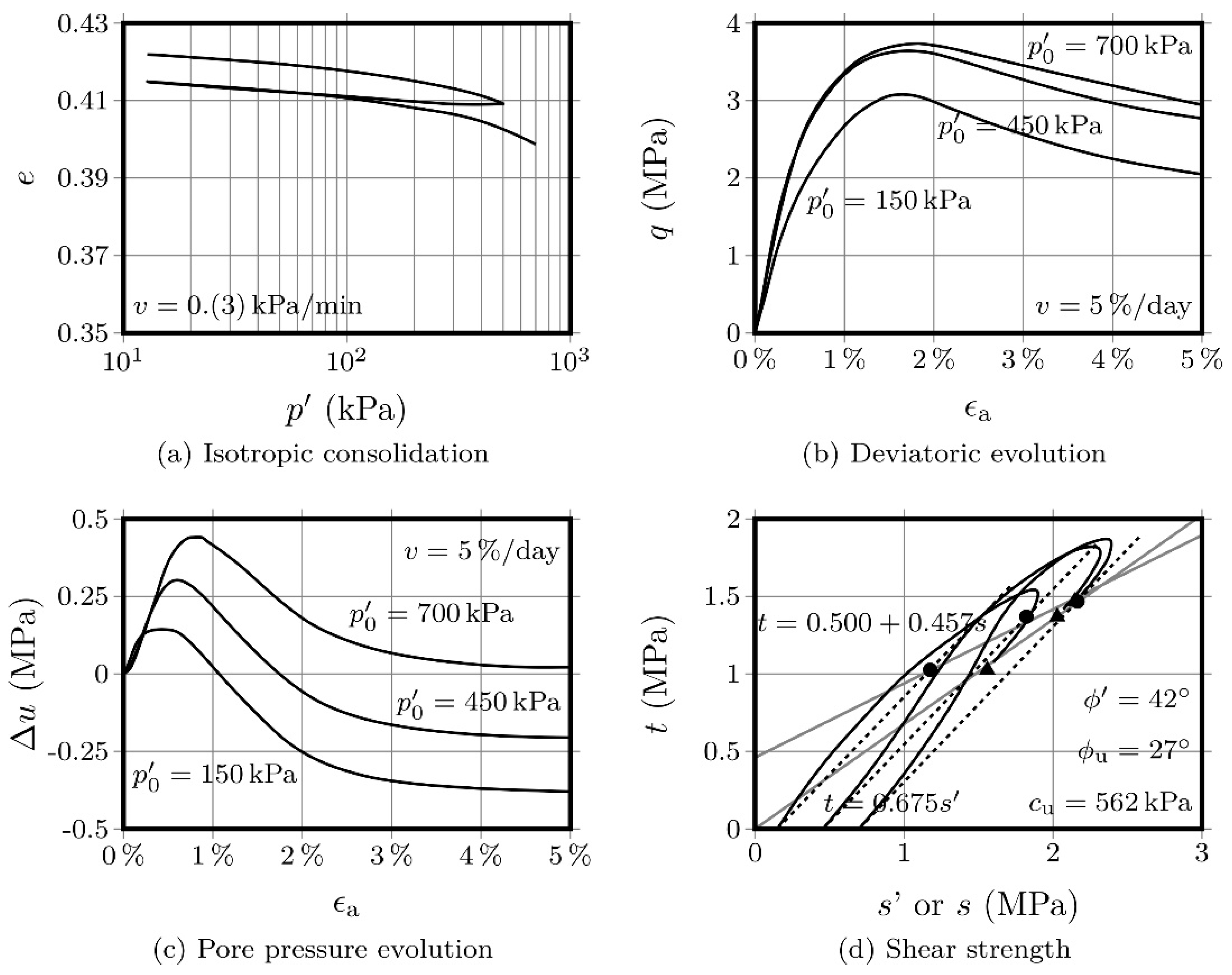
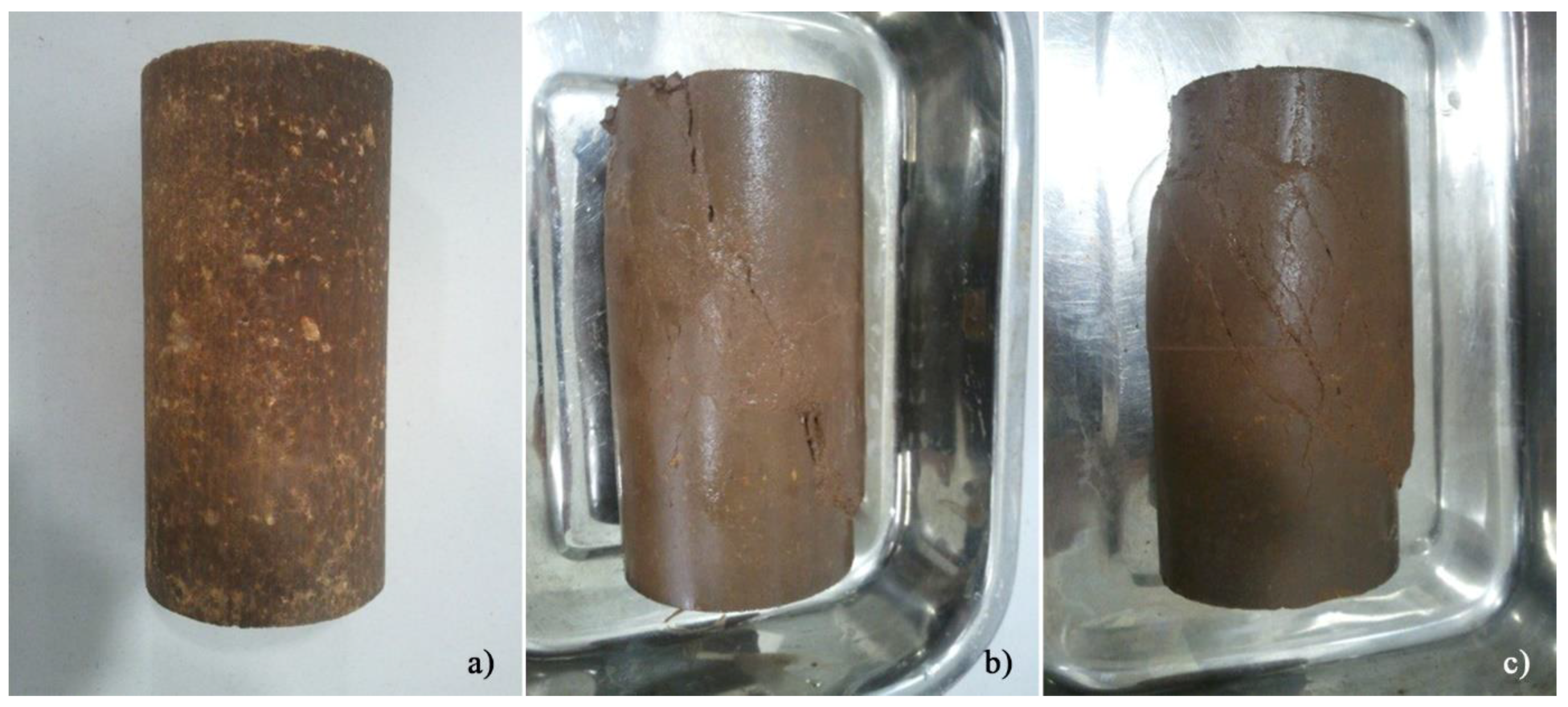
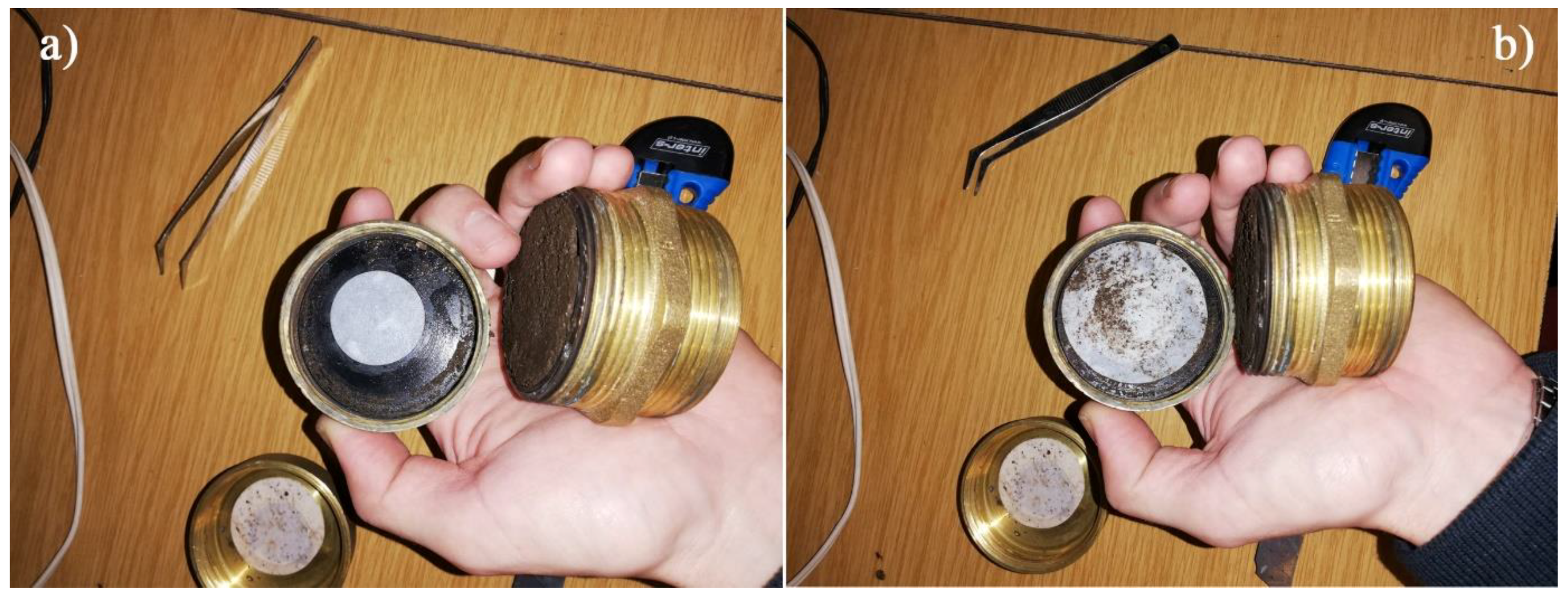
| Property | Value |
|---|---|
| Sand (%) | 39.3 |
| Fines (%) | 60.7 |
| Liquid limit (%) | 28 |
| Plasticity limit (%) | 19 |
| Specific gravity | 2.54 |
| Element | wt.% |
|---|---|
| Al2O3 | 20.82 |
| CaO | 1.84 |
| Cr2O3 | 0.02 |
| Fe2O3 | 8.62 |
| K2O | 2.75 |
| MgO | 1.94 |
| MnO | 0.06 |
| Na2O | 1.08 |
| SiO2 | 60.00 |
| SO3 | 0.88 |
| Outros | 1.64 |
| L.O.I. | 0.34 |
| Material | Dry Soil (wt.%) | Dry FA (wt.%) | Dry OPC (wt.%) | 10 m Activator Content (wt.%) | Water Content (wt.%) |
|---|---|---|---|---|---|
| Original soil | 100 | - | - | - | 14.4 (*) |
| OPC-S | 95 | - | 5 | - | 14.5 (*) |
| AAC-S | 80 | 20 | - | 19.2 (**) | - |
| Material | Maximum Dry Unit Weight (g/cm3) | Optimum Water Content (%) |
|---|---|---|
| Original soil | 1.81 | 14.4 |
| OPC-S | 1.82 | 14.5 |
| AAC-S | 1.80 | 13.0 |
| Material | Consolidation Stress (kPa) | ||
|---|---|---|---|
| Test 1 | Test 2 | Test 3 | |
| Original soil | 50 | 100 | 200 |
| OPC-S 28 days | 10 | 450 | 700 |
| OPC-S 90 days | 10 | 150 | 700 |
| AAC-S 28 days | 10 | 150 | 700 |
| AAC-S 90 days | 150 | 450 | 700 |
© 2020 by the authors. Licensee MDPI, Basel, Switzerland. This article is an open access article distributed under the terms and conditions of the Creative Commons Attribution (CC BY) license (http://creativecommons.org/licenses/by/4.0/).
Share and Cite
Araújo, N.; Corrêa-Silva, M.; Miranda, T.; Topa Gomes, A.; Castro, F.; Teixeira, T.; Cristelo, N. Unsaturated Response of Clayey Soils Stabilised with Alkaline Cements. Molecules 2020, 25, 2533. https://doi.org/10.3390/molecules25112533
Araújo N, Corrêa-Silva M, Miranda T, Topa Gomes A, Castro F, Teixeira T, Cristelo N. Unsaturated Response of Clayey Soils Stabilised with Alkaline Cements. Molecules. 2020; 25(11):2533. https://doi.org/10.3390/molecules25112533
Chicago/Turabian StyleAraújo, Nuno, Manuela Corrêa-Silva, Tiago Miranda, António Topa Gomes, Fernando Castro, Tiago Teixeira, and Nuno Cristelo. 2020. "Unsaturated Response of Clayey Soils Stabilised with Alkaline Cements" Molecules 25, no. 11: 2533. https://doi.org/10.3390/molecules25112533
APA StyleAraújo, N., Corrêa-Silva, M., Miranda, T., Topa Gomes, A., Castro, F., Teixeira, T., & Cristelo, N. (2020). Unsaturated Response of Clayey Soils Stabilised with Alkaline Cements. Molecules, 25(11), 2533. https://doi.org/10.3390/molecules25112533







